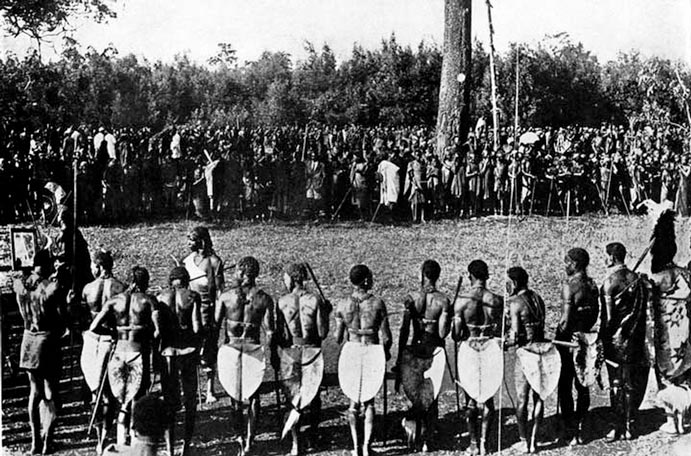The views expressed in our content reflect individual perspectives and do not represent the authoritative views of the Baha'i Faith.
In this day the choicest fruit of the tree of knowledge is that which serveth the welfare of humanity and safeguardeth its interests. – Baha’u’llah, Tabernacle of Unity, p. 10.
In the highlands of Kenya, Richard St. Barbe Baker, a young British forester, saw the soil eroding away, and the land turning into desert where trees once grew. He consulted with the chiefs and elders of the Kikuyu people there, and an idea was born.
The clans of the tribe always held a dance when they began something important, so St. Barbe proposed that they hold a “Dance of the Trees”. Over three thousand Kikuyu warriors took part. With that dance, The Men of the Trees began, an organization that went on to establish branches in one hundred and eight countries.
(This picture may someday be regarded as one of the most important photographs in the history of the environmental movement. It documents the event that led to an entire population changing their culture, almost overnight, in order to restore their natural environment. It marks the successful modern-day birth of social forestry.)
As the work unfolded in Kenya, nine thousand tribesmen joined in planting and tending the trees. In a special ceremony, the leaders there made St. Barbe Baker a member of the Kiama, the tribal council of elders–the first white man ever honored in this way.
After leaving Kenya for three months to take part in tree planting in Tanganyika, he returned to a shocking discovery. A Colonial official had destroyed eighty thousand seedling trees—that the volunteer Kikuyu Men of the Trees had raised by hand—to build a tennis court.
Although distressed and disgusted by this wasteful act, St. Barbe conveyed to the Men of the Trees a plea for a new beginning. As a result, the warriors in the region planted over nine million new trees that year.
Then, another incident occurred that the tribal people in that part of Africa would long remember. A Colonial official tried to strike a Kikuyu farmer with a blunt instrument, and St. Barbe risked his career by stepping in between the two and taking the hard blow on his own shoulder. This act of courage became a turning point in his life. For his “insubordination,” he was sacked from his post in Kenya and later assigned to a more dangerous, malaria-ridden station in Nigeria.
This, in turn, resulted in launching him on a path of service that led to free-lance forestry endeavors around the world. We have briefly surveyed some of these activities in Part 1 and Part 2 of this series of articles.
From early childhood it seems that St. Barbe Baker’s destiny had been intertwined with trees and forests. He grew up in the pastoral countryside of England where he had a mystical experience at the age of five that left a lifelong imprint on him. He got lost in the forest, and many years later recalled:
…I seemed to have entered the fairyland of my dreams. I wandered on as in a dream, all sense of time and space lost…buoyed up with an almost ethereal feeling of well-being, as if I had been detached from earth. I became intoxicated with the beauty around me, immersed in the joyousness and exaltation of feeling part of it all… Rays of light pierced the canopy of the forest… I had entered the temple of the woods. I sank to the ground in a state of ecstasy; everything was intensely vivid… The overpowering beauty of it all entered my very being. At that moment my heart brimmed over with a sense of unspeakable thankfulness which has followed me through the years since that woodland rebirth.
Perhaps this early epiphany laid a foundation, opening his heart to respect the spiritual teachings and treasure the spirit of brotherhood he experienced with the Kikuyu in the African forests. In the autumn of 1924 St. Barbe attended in London the ‘Conference on Some Living Religions in the British Empire.’ There he presented a paper entitled ‘Some African Beliefs concerning the Faith of the A-Kikuyu.’ The other presentations at this conference included two papers on the Baha’i Faith.
After his talk, he was approached by a Baha’i, Claudia Stewart Coles, who said, “You are a Baha’i. You are just as interested in the other man’s religion as your own.” He responded, “This is so.” Just before he left for Nigeria ten days later, she gave him his first Baha’i books, which initiated a lasting friendship.
In 1935, almost four years after Claudia’s passing, he wrote to another Baha’i, Martha Root, “I have had extraordinary success in my work. Looking back I realize how much of my success was through the spirit I caught from Claudia.”
Our hope is that, God willing, the breeze of mercy may blow, and the divine Springtime clothe the tree of being with the robe of a new life; so that we may discover the mysteries of divine Wisdom… – Baha’u’llah, The Book of Certitude, p. 129.

















Comments
Sign in or create an account
Continue with Googleor